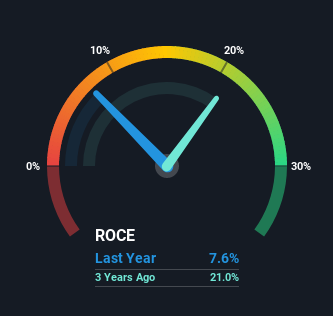- Hong Kong
- /
- Personal Products
- /
- SEHK:157
The Returns On Capital At Natural Beauty Bio-Technology (HKG:157) Don't Inspire Confidence

If we're looking to avoid a business that is in decline, what are the trends that can warn us ahead of time? Businesses in decline often have two underlying trends, firstly, a declining return on capital employed (ROCE) and a declining base of capital employed. Basically the company is earning less on its investments and it is also reducing its total assets. Having said that, after a brief look, Natural Beauty Bio-Technology (HKG:157) we aren't filled with optimism, but let's investigate further.
Return On Capital Employed (ROCE): What is it?
For those that aren't sure what ROCE is, it measures the amount of pre-tax profits a company can generate from the capital employed in its business. The formula for this calculation on Natural Beauty Bio-Technology is:
Return on Capital Employed = Earnings Before Interest and Tax (EBIT) ÷ (Total Assets - Current Liabilities)
0.076 = HK$49m ÷ (HK$885m - HK$237m) (Based on the trailing twelve months to June 2021).
So, Natural Beauty Bio-Technology has an ROCE of 7.6%. Ultimately, that's a low return and it under-performs the Personal Products industry average of 11%.
See our latest analysis for Natural Beauty Bio-Technology

Historical performance is a great place to start when researching a stock so above you can see the gauge for Natural Beauty Bio-Technology's ROCE against it's prior returns. If you're interested in investigating Natural Beauty Bio-Technology's past further, check out this free graph of past earnings, revenue and cash flow.
What Does the ROCE Trend For Natural Beauty Bio-Technology Tell Us?
There is reason to be cautious about Natural Beauty Bio-Technology, given the returns are trending downwards. Unfortunately the returns on capital have diminished from the 22% that they were earning five years ago. Meanwhile, capital employed in the business has stayed roughly the flat over the period. Since returns are falling and the business has the same amount of assets employed, this can suggest it's a mature business that hasn't had much growth in the last five years. If these trends continue, we wouldn't expect Natural Beauty Bio-Technology to turn into a multi-bagger.
The Bottom Line
In the end, the trend of lower returns on the same amount of capital isn't typically an indication that we're looking at a growth stock. It should come as no surprise then that the stock has fallen 24% over the last five years, so it looks like investors are recognizing these changes. Unless there is a shift to a more positive trajectory in these metrics, we would look elsewhere.
One final note, you should learn about the 2 warning signs we've spotted with Natural Beauty Bio-Technology (including 1 which is a bit unpleasant) .
For those who like to invest in solid companies, check out this free list of companies with solid balance sheets and high returns on equity.
If you're looking to trade Natural Beauty Bio-Technology, open an account with the lowest-cost platform trusted by professionals, Interactive Brokers.
With clients in over 200 countries and territories, and access to 160 markets, IBKR lets you trade stocks, options, futures, forex, bonds and funds from a single integrated account.
Enjoy no hidden fees, no account minimums, and FX conversion rates as low as 0.03%, far better than what most brokers offer.
Sponsored ContentValuation is complex, but we're here to simplify it.
Discover if Natural Beauty Bio-Technology might be undervalued or overvalued with our detailed analysis, featuring fair value estimates, potential risks, dividends, insider trades, and its financial condition.
Access Free AnalysisThis article by Simply Wall St is general in nature. We provide commentary based on historical data and analyst forecasts only using an unbiased methodology and our articles are not intended to be financial advice. It does not constitute a recommendation to buy or sell any stock, and does not take account of your objectives, or your financial situation. We aim to bring you long-term focused analysis driven by fundamental data. Note that our analysis may not factor in the latest price-sensitive company announcements or qualitative material. Simply Wall St has no position in any stocks mentioned.
Have feedback on this article? Concerned about the content? Get in touch with us directly. Alternatively, email editorial-team (at) simplywallst.com.
About SEHK:157
Natural Beauty Bio-Technology
An investment holding company, provides skin care products and services in Mainland China, Taiwan, and internationally.
Mediocre balance sheet minimal.
Similar Companies
Market Insights
Community Narratives




